Garlic Planting Conundrums, Part 2, in which we ask, where can you fit garlic in a permaculture landscape, what about companion planting with garlic, and what is the most efficient way to grow really great garlic?
So, in my earlier post, we talked a bit about figuring out where to plant the garlic from year to year, and how it can be a lot of work to break new ground and turn it into something soft and loose enough to grow a well-rounded, firm, disease-free, long-lasting, ultimately flavorful head of garlic, which is what we’re all after, right?
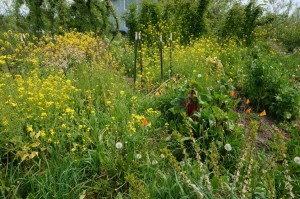
In this post, I thought I might continue that train of thought and explore a few options on where else you might plant it, in case you are still deciding. (If you STILL haven’t gotten yours in the ground yet, not to worry! There is still time! In fact, I just finished tucking mine in the other day – November 5, to be exact – which is later than I usually do, but is still good. The idea is to give the bulbs a chance to grow a few roots to anchor them in place during freezing and thawing over the winter, but to minimize the top growth to lessen winter damage to tender shoots.)
Before we go through all that work to build something brand new, though, I thought it might be a good idea to revisit the possibility of the here-and-there method.
Which brings us to…
Dilemma #1: Where can you grow a good crop of garlic in a permaculture-like landscape?
I mean, what if you don’t WANT to break new ground or don’t have the luxury of having it available? Some may have chuckled at my garden plot schematic – others may have outright gasped – but if you have ever plotted out your garden on paper, it is an eye-opener to see just how it all fits together (or not, as the case may be!)
I know, I know – I spent a long time measuring things and drawing them and putting them into different programs on the computer (and ended up just going back to plotting it in Excel) to give myself this reality check. I had pretty much come to the conclusion that breaking new ground was the path forward – BUT – and this is a decision-with-consequences BUT – I still felt there OUGHT to be a place for the garlic in the garden we have. I just needed to make better use of the space. So much of it is grass – not other groundcovers. The shrubs are still small; the schematic illustrates what they will be full size. And hey, garlic is supposed to be a superior companion plant, right?
You might wonder just how I got in this fix in just 3 quick years (time flies so quickly when you’re busy planting!). I would rather refer to it as Evolution.
How I Got Here from There – a short (I promise!) side-story that leads to a bigger picture
The transformation started with a decision to create more habitat for wildlife, because I felt the birds were too dependent on me for their winter food. I could not have chickens because we like to travel, but I could definitely make a home for the birds and reap many of the same benefits of insect control, fertilization, and the pure enjoyment of having them around. I also needed a good windbreak so my garlic could grow perpendicular to the ground (what a concept!).
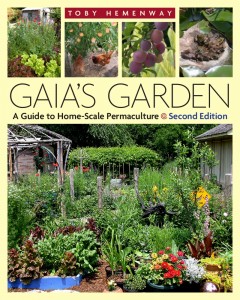 In my search for answers, I came across Gaia’s Garden by Toby Hemenway. This book was a deal-changer for me. I started searching out perennial vegetables, more berries, and an assortment of useful plants. Years ago, I used to grow over a hundred varieties of herbs. It was time to resurrect some of these. Then, it only seemed natural to have a beehive or two; my husband, being handy with wood, built a couple of Warré hives. And from there, as I focused on providing chemical-free pollen and nectar for the bees across the seasons, the garden simply exploded.
In my search for answers, I came across Gaia’s Garden by Toby Hemenway. This book was a deal-changer for me. I started searching out perennial vegetables, more berries, and an assortment of useful plants. Years ago, I used to grow over a hundred varieties of herbs. It was time to resurrect some of these. Then, it only seemed natural to have a beehive or two; my husband, being handy with wood, built a couple of Warré hives. And from there, as I focused on providing chemical-free pollen and nectar for the bees across the seasons, the garden simply exploded.
Does life get more complicated, or does it just get more intertwined?
The interconnectedness of all these systems is the real beauty of this type of gardening.
So – permaculture, as in permanent agriculture, as in more perennials, has been where my garden has been evolving for quite some time. However, as I planted more and more berries, shrubs, trees, perennial vegetables, herbs, and flowers, the 6-plot plan around which I conveniently rotated my garlic was simply no longer available.
Solutions – or Not
At first, I tried to work around it. A couple of years ago, I planted the garlic in circles around my nitrogen-fixing shrubs of Autumn Olive (Elaeagnus umbellata) and Wolfberry (Lycium barbarum). It was artistic, beautiful, fun, unconventional, and this is key – a bit of a trick to water. Plus, as the shrubs grew larger, the garlic received less sun and air flow, and I ended up with a real rust problem by season’s end. On the flip side, the shrubs provided some wind protection, which can be a problem here, and other garlic growers in our area also experienced rust that year, due in large part to incessant rain and unseasonably cool temperatures. (In fact, it rained and rained right around harvest time, and we were faced with the dilemma of harvest now and risk molds from difficulties in curing – or – harvest later and risk everything being overmature.) Considering the season’s challenges, my garlic still did quite well (the majority of my losses were in the curing, but that’s for a different post).
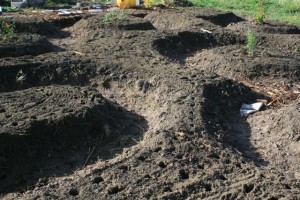

The point I really want to make, though, is that this alternative method of planting the garlic, although a bit unusual, totally fit into the emerging food forest. And it definitely was NOT boring!
Plus, I learned a few things...
The key thing I learned was that I had created a series of microclimates within one of the plots. In planting in a circle around the shrubs, the north side received less sun. The willows on the south border grew taller than expected, and when they leafed out, shaded the area more than I thought they would. The Autumn Olive and Wolfberry plants likely contributed some nitrogen to the soil, from which the garlic likely benefited. I know for sure the dandelions grew like crazy (which were a different challenge). And then there were the aforementioned watering issues; fortunately, the Autumn Olive and Wolfberry did not mind when I cut the water back in mid-summer. Technically speaking, however, I was still growing a mono-crop of garlic; it just wasn’t in conventional rectangles.
Whoa whoa whoa! Isn’t the Mono-crop Mentality what we are trying to get away from here? What about the importance of polycultures? Isn’t one of the main ideas of permaculture to plant a variety of plants together to take full advantage of each of their strengths and counterbalance their weaknesses?
Building Guilds and Companion Planting with Garlic in a Permaculture Landscape
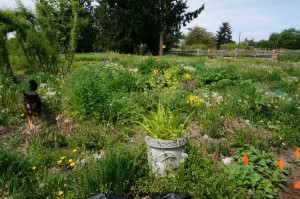
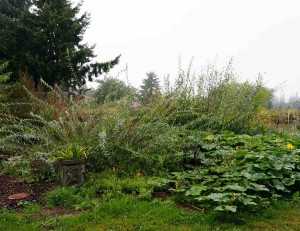
This is true. The fun part of permaculture is in creating the guilds, i.e., putting together groups of plants that all grow together at different heights and depths to take full advantage of space and time. Permaculture planting is about combining characteristics in such a way that the unique attributes of each individual contribute to the well-being of the whole. One and one make three; companion planting taken up a notch. In permaculture thinking, monoculture is bad; polyculture is good. The combinations are infinite.
So if you are a Carrots Love Tomatoes fan, then you know common companions to garlic are strawberries and tomatoes. Don’t Do It!!! Why???? Because come July, when the leaves start dying back on the garlic, you have to cut off the water! Essentially, you let the garlic start to cure in the ground. And this is NO time to cut back the water on your water-loving fruits!
Some say plant garlic with carrots. Keep in mind, garlic and carrots compete for the same root space. Will the garlic confuse carrot flies and aphids? Repel moles? Maybe. Sometimes it is hard to say what would have been. (I DO get voles and moles in my garlic beds, but not too many.)
And how about planting around fruit trees? Tree roots grow deeper where it shouldn’t be a competition problem – EXCEPT that fruit trees, by their very nature, provide shade – and your garlic likes sun – so you are limited by where you might find that sunlight. (That said, I frequently plant garlic under my fruit trees, but they are primarily for pest protection, not consumption. And they usually get tromped on. I also tuck them in with our roses.)
Not that anything can’t be done with a little creativity.
My question for you is, How big is a guild? Is it a small grouping of plants around a tree or other central figure? Or is it a group of groupings? Or either and both and more, extending into the landscape?
Permaculture Design Principles: Observe and Live on the Edge
So many questions with multiple answers! It struck me one day as I was working up a sweat in what I was beginning to think of as a slave labor camp, that the key to planting garlic in a permaculture landscape could be found in going back to some of the basic permaculture design principles. The first one is to OBSERVE and INTERACT:
By taking time to engage with nature, we can design solutions that suit our particular situation [David Holmgren].
So, leaning on my shovel, squinting toward the south, I thought, ‘Where is the sun?’
It might seem obvious, but a food forest, even a very young one, tends to be a bit shady. It was then I was hit in the head by an epiphany (although it might have been a passing bird): another basic permaculture design principle is to OPTIMIZE THE EDGE:
The edge—the intersection of two environments—is the most diverse place in a system, and is where energy and materials accumulate or are transformed. Increase or decrease edge as appropriate [Toby Hemenway].
The EDGES are the most dynamic areas of the garden. I suddenly realized I needed to pay more attention to this important border of drama. The EDGES are where you will find the most sunshine. I also suddenly realized that in planning future garlic beds, I did NOT need to till up large sections of land; all I needed to do was gradually expand the garden by increasing the BORDERS. Throughout the year, I could pile the mulch around the outside perimeter, which by fall would be transformed into a soft soil. Sure, this would mean the garlic would be planted in a long winding strip, which might still be a challenge to water, but not nearly as much as inter-planting here and there throughout the landscape. The bulbs would also stand guard around the garden as vole patrol. This is my plan for next year for 2015 harvest (always thinking 2 years ahead, right?) It is too late for it to happen this year.
So – Final Answer – Where Does the Garlic Go?

It strikes me that if you have hung in here this far, we are still trying to answer this basic question. So it may surprise some that I am continuing with the mono-crop mentality for this year’s garlic. I guess what it came down to for me was more of an issue of convenience. If you grow garlic on a large scale – and I realize, by most farmer’s standards, I am small potatoes here – but by many other’s, when I tell them how much garlic and how many kinds I grow, their eyes get wide, and the common response is, “I had no idea there even were that many varieties!” – so if you grow garlic on a large scale, however you define it, and especially if you want to make it a cash crop, the weeding, fertilizing, and watering are easier to keep on top of if everything is more-or-less together. As a small business, quality is very important, as is efficiency, and like it or not, size sells. It’s a matter of balance, and having time for other things factors into that equation.
My permaculture garden looks like a jungle of “weeds” (again, it’s a matter of definition here). But reality is, garlic would have a hard time competing in there. Garlic tends to be a bit of a high-maintenance crop. For the love of garlic, I keep after it, even when I leave everything else to their own devices. And that’s how I grow great garlic, all other things falling into place, the stars being aligned, and the weather gods smiling.